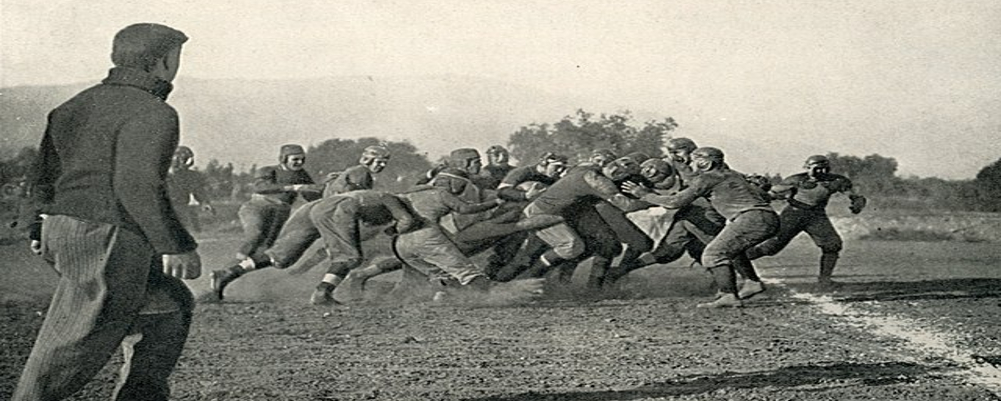If you love the football talk on the history and evolution, then you check out the original article Tim wrote Helmet-Tossing Trickeration.
Also check out the podcast version of our chat at They Tried This Football Gadget Play With the Helmet! Pigskin Dispatch Podcast.
Transcribed Toss leather Helmet Trickeration with Tim Brown
Hello, my football friends; this is Darin Hayes at PigskinDispatch.com. Welcome once again to The Pig Pen, your portal to positive football history, and welcome to another edition where we get to visit Timothy P. Brown of FootballArcheology.com on a Tuesday and talk about some gridiron from yesteryear and some great aspects of the game. And Tim's got some great stories today in our edition.
Tim, welcome back to The Pig Pen.
Hey, Darin. Good to see you.
And what could I use as a dad joke? I think I'm out of luck. I don't think I have anything. Yeah, I think you're tricked out.
Yeah, that's... I figured that's what you were setting yourself up for. But of course, Tim... Oh, go ahead. I'm sorry.
Well, I was just going to say that I was being the, you know, the straight man in this little comedy routine. And usually, those don't work out so well when you're the straight man, and I'm telling the jokes. Your delivery is much better than mine.
Of course, we're trying to segue into kind of very poorly, I might add, into Tim's great article that he wrote back in July 5th called The Helmet Tossing Trickeration, which, you know, sounds like a mouthful here. And I'm sure we'll have a few more laughs and learn a lot about some football here with this story. Yeah, so I will take a moment; hopefully, in the very near future, my next book, A History of the Football, will be released and available for sale by Football History Enjoying Public.
Anyways, one of the things that I cover in that book is, you know, when and why stripes arrived on the ball. And so stripes basically came, you know, appeared on footballs for two reasons. One is that they were added to help people see the ball when they played night games or when they practiced at dusk.
You know, a lot of times you just would paint a ball white or yellow, but those were slick and slippery. And so they, you know, adding a stripe, you know, they thought would allow, would cause less problems with, you know, the slickness of the ball. So part of it, white stripe or a black stripe on a white ball was just to help people see at night.
But the other thing that, the other reason was to eliminate kind of a camouflage effect. And so, you know, the stripes got added in the 20s, mostly in the 30s. But, you know, back then teams were just starting to wear white jerseys on a fairly regular basis.
Stanford was one of those teams. But so if you used a white ball at night, it was like, okay, well, the opponent was like, well, we can't see the ball because you got white jerseys. And then back, and the same thing kind of happened with the brown ball.
Teams, not many teams wore brown or tan jerseys, but almost everybody was wearing pants that were earth tones. They were khaki. So they were, you know, they were the khaki color or they were brown, or they were, you know, some kind of a greenish brownish blob.
And so it would sometimes be hard to see the ball against that background. And so, and they were also, a lot of teams were wearing, you know, that there were friction strips, but before the friction strips, they'd wear those like pieces of leather that were kind of oval looking on their jerseys. And so, so anyways, for those reasons, it was sometimes hard, you know, you'd lose sight of the ball because of the uniform that the, that the opponent was wearing.
So, so that was a problem. And in that time, there was also some trickeration that was going on. This is in the 20s and 30s, but there was another, there was an older trickeration that had occurred back in, in 1909, which is really the focus of this tidbit.
It's just taken me a little while to get there. So back in 1909, Virginia Tech and North Carolina were playing a game and Virginia Tech had three brothers named, well, their last name was Hodgson. And one of the guys was E.R. Hodgson, and he was the right guard.
Vivian Hodgson ends up, you know, scoring the first TD in the game and E.R., the guard, moves back to be the kicker. This is not him, but you know, figured I'd put a kicker out here. And so, you know, he converts the, converts the kick.
So Virginia Tech's, you know, leading. Five minutes later, Virginia Tech is on the 35 and E.R. Hodgson sets up again to kick, this time a field goal. And rather than, you know, as a snap is made, Hodgson, the kicker, pulls off his brown leather helmet, which is basically the same color as the football.
And he tosses the helmet over the right side of the line so that the, so that the NC State players would think that he was throwing a football. And instead, well, he was throwing a helmet, obviously, but the holder got the ball and he ran around the left side of the NC State line and goes for a 35-yard touchdown. So it's just, you know, this is one of these things where the helmets look enough like a football in terms of just the tanning of the leather that you could throw your helmet and people would think it was a football.
And then in the second half, he sets up again and to place kick another field goal and the ball gets snapped. Instead of going to the, to the holder, the ball gets snapped to the E.R. Hodgson, the kicker. And it's, it's hard to, you know, the, the way they describe it, it's not entirely clear whether, you know, but he handed it off to the quarterback who maybe was positioned out at a wing position.
And it was either like in a draw or a Statue of Liberty sort of play, but the quarterback went for a 75-yard run, you know. So here's poor NC State, you know, they, they thought they were playing a pretty big, pretty good game until they saw ball flying over the, the left side of the defense line, turns out to be a helmet, not a ball. And then they get the old Statue of Liberty play, which was then a new play, pulled on them.
So, you know, two long touchdown runs and unfortunately for them anyways, Virginia Tech won. But so that, that one of the other side lights to this is that these, you know, these trick plays, throwing the helmet around, you know, people continue doing that a bit. And in like the late twenties, there was some guy, I've never figured out who he is, some guy, but he apparently played somewhere in the South.
And he, he would take, he was a running back, he'd take his helmet off and toss it to the ground, you know, sometime close to being tackled, because then some of the defenders would think it was a loose ball, go for the, go for the helmet instead of the, instead of trying to tackle him. And so then that was when they implemented a rule that said every team has to paint their helmets with some kind of striping, you know, cross stripes, or like, you know, kind of like the Michigan Wolverine, you know, type of helmet. You had to have some contrasting colors painted on the top of your helmet.
So it didn't look like a football. So anyways, that's all I know. That's it.
Yeah. That's quite a mouthful there of what you just said. I mean, some great, great stories.
First of all, you almost got to think of back how almost every episode of the A team ended back in the eighties where Hannibal would say, I love it when a plan comes together. It sounds like those, those trickeration plays were to their peak performance there on both of them getting a big touchdown plays, helping them win the game. But the other thing is you almost got to think, you know, it's hard for our modern sensibilities to say, okay, a player's taken off their helmet in the middle of a play.
You know, even in between plays when they're on the field, you know, nowadays they, you know, celebration, they get 15 yard penalties. So obviously that was not the rule back in that era. Well, you didn't even have to have a helmet, you know, at that, at that point.
So, yeah, I mean, you know, people by, well, actually in like oh nine, probably most players didn't wear one. Maybe half did, it probably depended on the team, but you know, certainly in the twenties and thirties, you know, then pretty much everybody was wearing them, but um, like Tommy McDonald, dude, I think he was the last one to play without a helmet. I'm pretty sure that was him.
Maybe, maybe I'm getting him mixed up with some, no, he was the last one to play without a face mask. Yeah. Yeah.
Okay. Yeah. Okay.
I think you alluded to it a little bit, and I think this is what you were talking about. If you go back, you know, back more towards the turn of the century and where the players, the standard equipment was, they were wearing like the vests, like the leather vests, you know, and you know, then the moleskin pants were that tannish color, like you're talking about in football. So I mean that era, and I think all teams were wearing, I don't think they had different color vests.
It was all the same color that had to be really challenging for a defense to be able to follow the ball and run the ball every play too. Yeah. I mean, so, you know, you basically had to rely on, you know, everybody wore long-sleeve sweaters or jerseys, and then they'd have a stripe, or they'd have socks of the same color.
So that was a primary way to tell. And it's like, you know, eventually college players kind of went to the no hose or no stocking look, you know, they just have the, but like the white sock, right. And, but back then everybody was still wearing shin guards.
And so, you know, the some, you know, early on, they'd wear them over their socks, and then they started wearing them under their socks. But I think the socks probably helped keep them on. And it was just a better look instead of having those shin guards.
But I was coming from the aspect of just trying to follow the ball when you have your midsection and your lower, you know, portions of your body are consumed the same color as the football. And, you know, there's 22 guys on the field like that. It's had to be extremely hard as a defender to follow where that ball is.
Yeah. And, you know, half the time, they were running up the gut. So it's like, you know, how they figured out who had the ball sometimes, you know, who knows.
And they weren't the nice clean fields that we see today either. I'm sure most of them were just mud pits. Yeah.
Especially the end of the season. Yeah. No doubt about it.
Yeah. Well, some interesting stuff and some things that we really have to appreciate that our football forefathers had to go through and experience both in the elements and by rules and some of the craziness of the absence of color in the uniforms and stripes on the ball that we take for granted. Of course, the NFL doesn't have the stripes, but almost every other level has some form of a stripe on there.
Now, I guess that's the other thing I'm sitting here trying to envision when you're putting stripes on balls back in the early twenties. It's not like they had, you know, masking tape and spray paint that they could put it on. So I'm assuming somebody's got to almost like detail this, you know, with a stripe with a brush and very little template.
Somebody with a steady hand and some kind of tape or something. But, you know, I mean, when the manufacturers got involved too, it was like, again, this is another thing I talk about in the book, but it's like, where do you put the stripes? Right. How many stripes? Do you have one stripe? Do you have two stripes? Do you have three stripes? Do they go just one way or do they go the long way? I mean, you know, so that there are these things that we take for granted that, well, of course, the white stripe goes there.
Well, no, that's an arbitrary place. I mean, there's probably reason why they ended up where they ended up, but, you know, I mean, they were just trying stuff, you know? So it's like, Billy, go paint white stripes on the ball. Okay, boss.
And, you know, Billy went and did it. Nobody told him how far it was supposed to be and how wide the stripes had to be or anything like that. Yeah, I think if I had to do it, it would probably look like a melted lightning bolt going around there.
I'm sure it wouldn't be going around. That'd be a tough thing to do on an odd shaped ball like that. I've got some images of the striping on the field as well that sometimes was not quite as straight as one might like.
I've experienced that in modern times when on the grass fields it's kind of hard to do measurements, that's for sure, when you have some of those crazy crooked lines in there. But, yeah, it's probably a better job than I would do, so I can't complain too much. Yeah, so, Tim, just another great way to look back at an aspect of football that it's hard for us to appreciate, but it happened and, you know, some of the things that people had to overcome playing the game that they love, just like we'd love it today, and we'd love just to hear about this history.
But you have some multi-times a week, you have some of these things coming up and writing articles on it, and maybe you could tell the listeners how they can enjoy some of these. Sure, just go to footballarchaeology.com and subscribe. All you have to do is submit an email address, and you'll start getting them every week or every time I post one.
Some of the stuff that I do, I, you know, only paid subscribers, you know, get access to it, but a lot of it is available for free. So, that's the best way. You can also follow me on Twitter, on threads, or on the Substack app.
All right, and keep us posted when that book comes out, so we can get the word out and get that in people's hands and enjoy the history of football and some of the aspects you learned about today, and we're going, I'm sure, in better detail in the book. So, Tim, we'd love to have you again next week, and we thank you for joining us today. Very good.
Thanks, Darin



